
Hull Geological Society

News archive 2021-2022
Copyright Hull Geological Society.
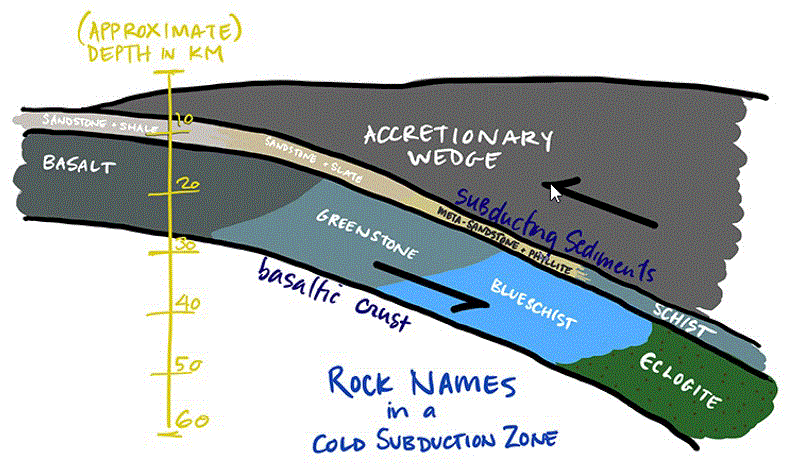
Abstract –
This talk returns to the topic of Subduction and the
rocks that have been through that process. Unlike the cherts found in abundance
in and around San Francisco, which have hardly been subducted at all, there are
many fewer examples of rocks of the blueschist facies, whose original,
un-metamorphosed minerals have been transformed by high pressures and
not-so-high temperatures. These rocks are interpreted to have descended as the
Farallon Plate was subducted under the North American Plate, being changed in
their mineral content at considerable depth, and then “exhumed” to the surface
again. The rarest of these very dense rocks is eclogite, found in one or two
locations near San Francisco - its mineralogy proves that it has been subjected
to very high pressures before being raised to the surface, by mechanisms that
are still poorly understood.
In the talk, we’ll review
how geologists have developed the pressure/temperature theories that yield these
“exotic” rocks, and, to a certain extent, have replicated these high -pressure
minerals in the laboratory. There’ll be photos from the half dozen blueschist
facies locations near San Francisco, plus some examples of similar subducted
rocks from other parts of the world.
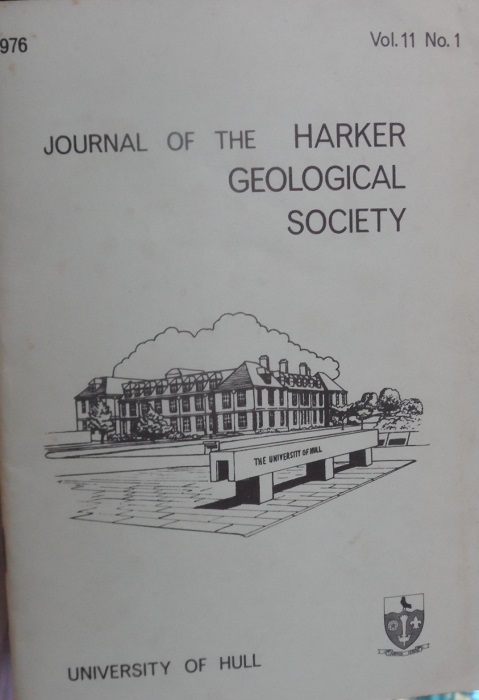
The Harker Geological Society at the University of Hull is planning to digitize its archives and has agreed that works about the geology of East Yorkshire can be republished by the Hull G.S. on our website. We thank the Secretary (Jan Silva) and President (Louis Chambers) for their help.
Mike Horne (HGS Honorary General Secretary) has been awarded the Moore Medal by the Yorkshire Geological Society in "acknowledgment of services to geology in the north of England". Click Here to read Mike's Acceptance Speech.
Humberside Geologist - the editors have decided to start a new volume for 2023. At present there are no plans to produce a printed version of Number 16.
Wednesday 16th November 2022 - John Connor on "Coastal
Erosion & Accretion in Holderness,
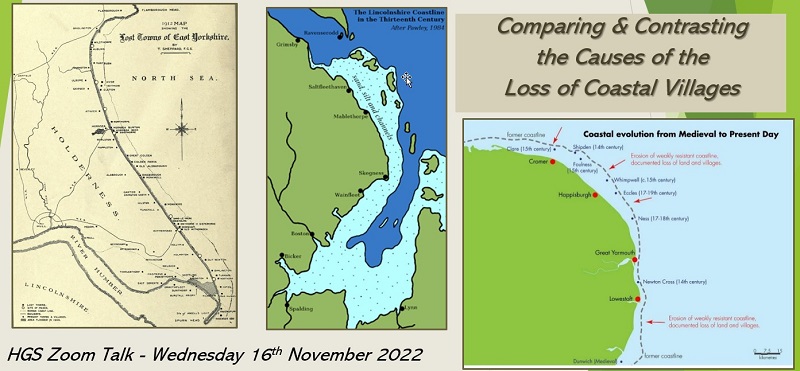
Abstract -
Dozens of villages along the coasts of the eastern
counties of England, whose existence had been well documented in various
medieval manuscripts, such as Domesday Book
and the Chronicles of Meaux Abbey,
were subsequently “Lost to the Sea”. The cause of this loss was, of course,
coastal erosion, but there are apparently big variations along these coasts in
the number of villages lost, so there must have been significant differences –
geological, geomorphological and probably historical – which account for these
variations.
This talk will attempt to illustrate, by comparing & contrasting, a range of
factors that together might explain the differences between the 4 coastlines and
describe what (if anything) has been, and is being, done to mitigate further
loss of these coastlines.
Understanding the
local rocks is crucial in planning how we prepare for increased subsidence,
flooding and coastal erosion due to climate change in our area. The potential of
fracking for shale gas within the deep geology is providing us with a topical
controversy. However, the most important role of the rocks is to provide a
never-ending interest for the members of the Hull Geological Society!
Winter Programme 2022-2023- "Due to continuing uncertainty about the Secretary’s health the Committee has decided not to restart indoor Club Nights and lectures until the Secretary has fully recovered from the treatment. We still plan to continue to run some meetings on Zoom, Club Nights on Facebook and pop-up field meetings, which will be advertised on our website and by e-mail. We apologise for the inconvenience caused to members, especially those who do not access e-mail or the internet."
Wednesday 14th September 2022 - Zoom talk at 7-30pm - John Connor on
"Geology
of Red Rock Canyon, Nevada"
Not far to the west of the gambling
dens and fleshpots of the Las Vegas Strip is the Red Rock National Conservation
Area – a wonderful place to admire the geology by hiking along the many trails
that wind across the desert, into, and then through several mountain canyons.
Although it’s the name “Red Rock
Canyon”, coming from the strongly coloured Miocene Aztec Sandstone, which most
attracts the day-trippers from Las Vegas, it’s the Keystone Thrust that
geologists come to admire, putting Palaeozoics on top of Lower Mesozoic rocks.
This talk
will feature photos taken on three visits to the area in the winters of 2015,
2018 and 2019, with an attempt to explain its long and complex structural and
stratigraphical geologic history. There’s also evidence of more recent
movements – that of the first indigenous people arriving to inhabit these cool
canyons, around 11,000 years ago.
The Secretary apologizes for having to postpone the August and September Club Nights, but he will not be available to facilitate them, nor lead the field trip to South Ferriby. Hopefully they can be re-arranged later.
Wednesday 20th July 2022 - Zoom talk at 7-30pm - John Connor on "More Chert Than You Can Shake A Stick At".
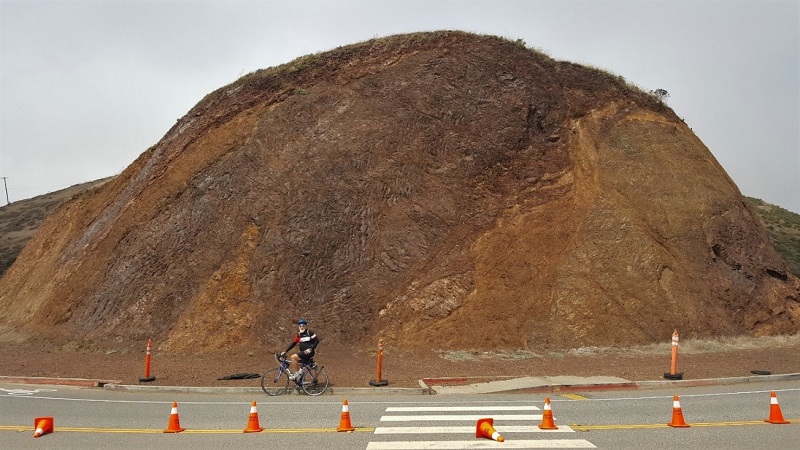
Abstract -
Chert, along with Flint, is probably
the most common form of the mineral Silicon Dioxide. Chert itself has more than
one form – the subject of this talk will be
radiolarian ribbon chert,
which is deposited, according to a definition by USRA, as “a
type of quartz formed when single-celled radiolarians living in the ocean die
and sink to the bottom of the ocean. Their skeletons are made of silica (SiO₂)
and they accumulate in beds hundreds of feet thick”.
There’s a lot of chert in the San Francisco Bay Area, essentially all of it
coming from deep-sea sedimentary deposits near the ocean-floor spreading centre
of the Pacific and then transported eastwards to impact the North American
continent. During this collision the chert is partly subducted/mainly crumpled
into the “accretionary wedge” that forms the structurally very complex geology
in and around San Francisco.
This talk will describe the current geologic thinking about the formation,
transport and deformation of the Bay Area ribbon chert. Because this rock is
very resistant to weathering, it forms ridges and is often seen in outcrop.
While these outcrops occur over a wide swath of the Bay Area, we’ll concentrate
on the Marin Headlands, immediately north of the Golden Gate, where the outcrops
are most dramatically displayed.
-o0o-
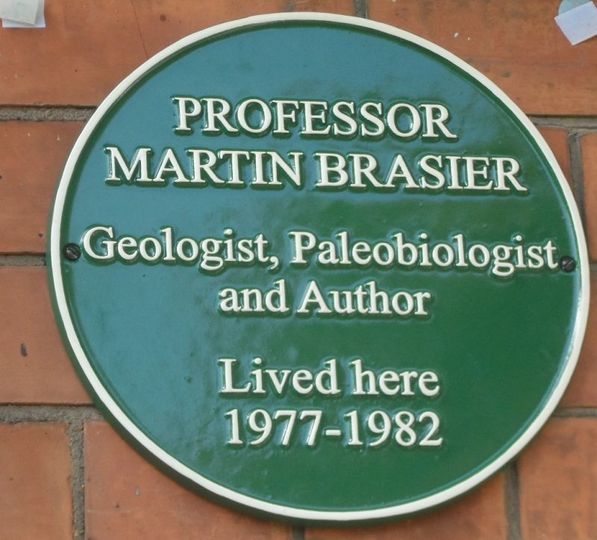
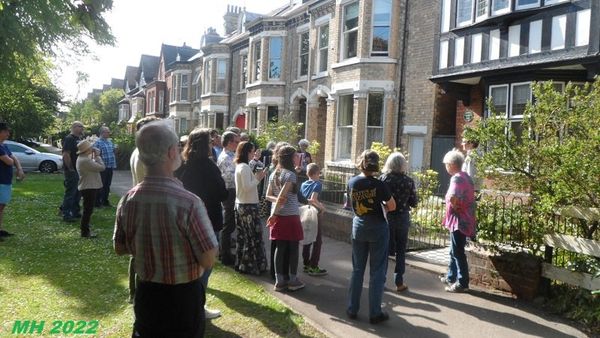
-o0o-
The Committee has
decided not to hold our usual Winter Programme of guest lectures at the
University in 2022-2023. There may be some talks on Zoom and informal talks at
the University.
-o0o-

(photo by R Connell)
Postponed
until further notice -
Walk in the footsteps of John Robert Mortimer on the
one hundred and eleventh anniversary of his death.
"John
Robert Mortimer (15/6/1825 - 19/8/1911)
"We should meet at the car park at
Cross Hill (pay and display unfortunately! See attached map) at 10.30am. An
additional pay and display car park can be found at Beckside/Cattle Market. We
will walk south down St John's Road, left into Lockwood Street, on to Middle
Street South, and finally to Riverhead (altogether about 1km) passing sites
related to Mortimers life and work. Afterwards walk back into town via
Middle Street South to the car parks. There are a number of cafes on the way for
refreshments! The walk could take an hour or an hour and a half I guess.
The Society apologies for changing the start times for the Spring and Summer 2022 meetings at the University to 6-15pm and appreciates that this may not be convenient for some members. This is because we are experiencing problems with access to the building in the evenings and we hope to be able to return to our normal start time of 7-30pm for the Winter Programme. The Committee has agreed to continue to have a mix of virtual and actual Club nights and talks for the forthcoming year. in his Annual Report for the AGM the Secretary commented "I do appreciate that some members do not have access to the internet and that some choose not to use Zoom or Facebook, but it does mean that ‘out of town’ members have the opportunity to participate in some of our activities when they live too far away to attend evening lectures in Hull, or prefer not to drive after dark."
Wednesday 13th April 2022 (rescheduled) –
lecture on Zoom by John Connor -
Abstract –
This talk was first given
to the Bay Area Geophysical Society, so you can expect to see some seismic
sections, and even a few equations, in the process of interpreting the seabed
geology.
From the Oil & Gas
Industries’ viewpoint, a mud volcano located on or near an oil or gas field that
is in the process of being developed is categorized as a Geohazard – that’s to
say, a geological, geomorphological or environmental feature, on or near the
seabed, that could seriously disrupt the engineering work required for the
installation of offshore development platforms and the associated sub-sea
equipment needed to safely extract the oil and/or gas.
In the South
Caspian Sea there are several such mud volcanoes, which have indeed required the
operators of the fields to identify them, and to avoid positioning their
offshore equipment on or near them. This talk will show how geophysics can be
used to identify areas of the seabed and near subsurface where geohazards are
present – it will focus on a particularly big mud volcano called Absheron.
Covid has not gone away. The Committee has decided not to restart indoor meetings in the early months of 2022. We hope that it will be safe to do so in March, starting with the Annual General Meeting.
Thursday 2nd
December, 2021, 19:30 Zoom meeting -
Abstract - Yorkshire has a rich and fascinating geological history… but what
about geo-archaeology?
Dr
Sam Griffiths works for MOLA – the Museum of London Archaeology practice. He was
the Discovery Programme Officer and lead archaeologist on the CITiZAN project in
the Humberside has a wealth of experience on multi-period archaeological sites
across the UK and Europe.
In October 2021 Arthur Speed sent a questionnaire to members asking what they valued about the HGS and for suggestions for the future.
Here are the suggestions and the actions we have taken -
|
You said |
We did |
|
Attract new members,
particularly younger people
|
Ten new members and families joined in the
2021-2022 season. We are planning Roadshows and other activities in 2022
to attract new members. Members are encouraged to spread the joy of
geology. |
|
Encourage student membership |
We now have closer links with the Harker
Geological Society and they now have a representative on our Committee. |
|
Restart activities after Covid |
Indoor meetings restarted in February 2022 |
|
Closer links with other societies |
We plan to have displays at the YGS event at
Caphouse Colliery in May and the Yorkshire Fossil Festival in
Scarborough in September. We will be helping the Geologists’ Association
at the Annual Conference in Hull in September. |
|
Hold discussion sessions during
Club Nights |
There is no reason why we cannot hold a debate
at a Club Night – please suggest a topic. Club Nights are quite informal
and we do chat a lot already. |
|
Develop the relationship with the University |
University students and staff are always
welcome at our meetings. |
|
Start a project to get members involved |
There are two projects ongoing (Flamborough
Quaternary and the Bisat Project), but please do suggest another one. |
|
Restart courses on Geology |
The geology courses were run by the
University’s Centre for Lifelong Learning – they did all the admin and
publicity and paid for the insurance and tutors. This would be beyond
our capabilities and funding. However we can include some seminars and
masterclasses in our programmes. |
|
Field meetings to a wider variety of sites lead by “new faces”. |
For the spring of 2002 we have planned a
weekend trip to Anglesey led by David Hill and to Wold Newton
Lincolnshire led by Martin Longshaw. All members are welcome to
volunteer to organise a field meeting – they don’t have to be “experts”. |
The Committee has co-opted Peter Carpenter into the role of Membership Secretary. Members addresses, e-mail addresses and subscription history (but not bank details) will be shared with Peter. You can contact Peter by using this e-mail address :
![]()
Wednesday 2nd June 2021 - evening zoom talk - Paul Hildreth on "The Good, the Bad and the Beautiful (an overview of the history, importance and future of Middlegate Quarry, South Ferriby)"
abstract -
Middlegate Quarry was opened to supply the local
works, established in 1938, with chalk, one of the raw materials required for
making cement. Clay, the other ingredient, was initially taken from local till
and alluvial deposits. A well-known and well-respected member of the Hull
Geological Society was responsible, at least in part, for the suggestion of
deepening the quarry to exploit an alternative source of clay when the original
became exhausted and its extraction threatened to de-stabilise the Humber bank
defences. Thus a gem of a geological site was created, a magnet for Mesozoic
research and a treasure trove of late Jurassic vertebrates and invertebrates,
particularly ammonites. Sadly, the cement works ceased production in early 2020.
The quarry has
become redundant and this has led to significant consequences for geologists.
But not all is lost!
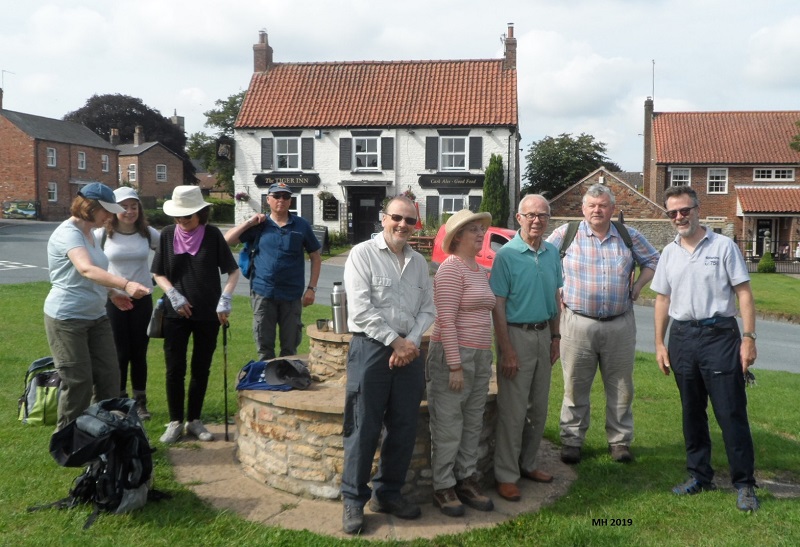
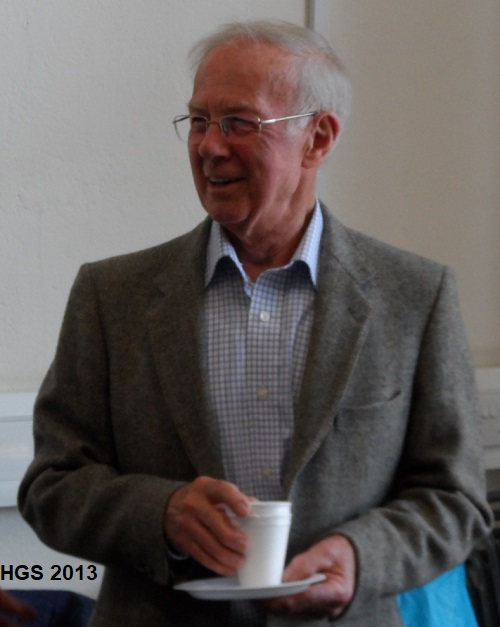
It is with sadness that I have to inform you that Barrie
Heaton passed away on May 14th 2021. Barrie joined the Hull Geological Society in
1995 and was an active member until recently. He was our Treasurer from 2002 to
2010, Vice President from 2010 to 2012 and President from 2012 to 2015. Barrie
was elected as an Honorary Life Member of the Society in 2017.
Wednesday 12th May 2021 – Zoom talk
–
“The Use of
Geophysics in Marine Archaeology”
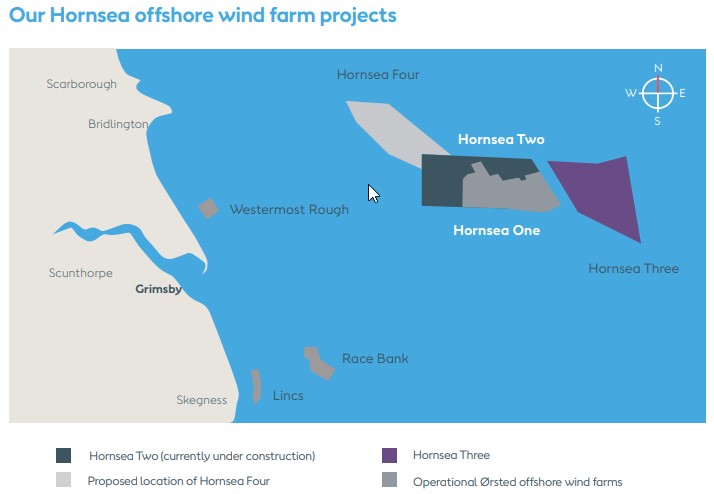
Abstract
–
The first
thing I should say is that I’m not an archaeologist. The idea for this talk came
about when I was browsing the internet for information about existing
high-resolution seismic data off the Holderness Coast. This search led me to an
Environmental Impact Assessment for the Hornsea Three Wind Farm, which is
expected to begin construction in 2023.
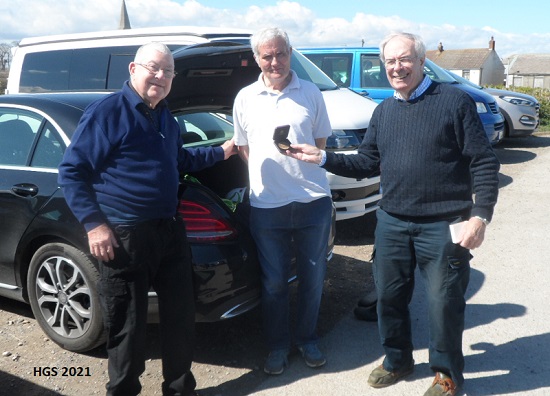
At the Bisat Research Group field meeting at Mappleton on 16th April 2021 the Secretary presented the 2021 Felix Whitham Memorial Medal to Graham Kings (on the right). Graham was awarded the medal “for leading the Bisat groups mammoth exercise of the photography of the glacial sediments of the entire Holderness cliffs (2014-2019). Curating and safeguarding the photo archive. And beginning the detailed stratigraphic logging of new and important sections in the cliffs.” Also in the picture are Dennis (on the left) and Arthur from the Group.
.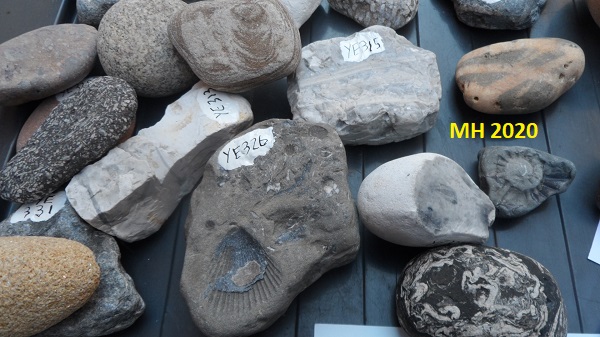
Thursday 8th April 2021 - Zoom lecture meeting - Mike Horne on "the Type Erratics collection"
Abstract –
Geologists have been studying the glacial erratics of Holderness and the
surrounding areas for about 150 years; is it now time to agree definitions of
these and work to the same standard? In this talk Mike will discuss some of the
problems and describes his plan to create a “type
collection” at the University of Hull.
The Secretary's Report for 2020-2021 is now available on our website

Wednesday 27th January 2021 - Zoom Talk - John Connor on Geomorphological Aspects of the San Andreas Fault
Abstract -
The geology of the San Francisco Bay
Area is complicated, to say the least. There are two main reasons for this –
first, and more important structurally, is the subduction of the Pacific Plate
under the North American Plate, from roughly 30 to 20 million years ago, though
there’s a section to the north, off the Oregon & Washington State coastlines,
which is still subducting.
Rocks subject to this subduction from
the Pacific oceanic crust have been crumpled into an “accretionary wedge”,
forming several small but very varied lithologic “terranes”, which stack up
across a roughly 30 mile west-to-east zone comprising the San Francisco Bay
Area.
This zone is demarked on the east by
the Hayward Fault and on the west, roughly parallel to the coast, by the San
Andreas Fault Zone. Between them, these two right-lateral strike slip faults are
responsible for moving rocks northwards, perhaps up to 200 miles from Southern
California to the Bay Area. The San Andreas Fault is the prime culprit and also
the second reason for the complicated geology of the area.
This talk will start by describing the
structural setting, followed by photos of local outcrops of some of the
terranes. Repeated earthquake movement on the San Andreas Transform Fault over
the past few million years has produced an elongate “valley”, onshore &
offshore. The remainder of the talk will be a photo tour, from north to south,
looking at 6 locations which, although all valleys of a sort, are
geomorphologically different.

Wednesday 4th February 2021 - Zoom Lecture - Professor Patrick Boylan, School of Arts and Social Sciences, City, University of London on "New light on the Neanderthals: music, rope-making. and now an apparent genetic link to Coronavirus"
Abstract -
The Middle and Upper Pleistocene Neaderthals have
generally had a bad press through more than a century and a half. Until
comparatively recently Neanderthals were widely regarded and caricatured as
primitive, clumsy and probably brutal, creatures. Knowledge, and more important,
attitudes have changed remarkably in the last 20 years or so, through many
additional discoveries and new interpretations of this hominin species. We now
know that Neaderthals were dominant across most of Europe and beyond from around
400,00 to 40,000 years ago, with significant populations stretching from the
Mediterranean and beyond out into what is now known as “Doggerland” – the vast
area of land under what is now the North Sea, while DNA studies show that
Neanderthal genes survive in many present-day populations.
More and more is also being discovered about the
culture and traditions of these populations.
I was able to help in a minor way with one of
the most remarkable indications of Neanderthal flute made out of the thigh bone
of a young Cave Bear. To most people’s astonishment the holes drilled through
the bone were in exactly the same relative positions as in a modern instrument,
and would have played the musical notes of the modern diatonic (Do, Re, Mi)
musical scale. Also, recent work in Gibraltar and elsewhere has found evidence
of both art and personal adornment with feathers.
In March 2020 an equally significant technological
discovery was made in France during excavations of Neanderthal levels within the
Abri du Maras Cave located in the Ardèche valley, a tributary of the River
Rhône. Due to preservation conditions organic remains other that bones and teeth
are generally very extremely rare. However, one of the stone flakes, 60mm long,
was found to have a tiny fragment of 3-ply cord adhering to the stone tool. On
microscopic examination the cord consists of fibres derived from the inner bark
of gymnosperm plants or trees, most likely conifers.
This
was not just the only startling Neanderthal discovery announced in 2020. Medical
reports of investigations into possible genetic risk factors for COVID-19
published in September and October 2020 show that
a Neanderthal derived gene cluster on chromosome 3 is
linked to respiratory failure in severe COVID-19 infections.
There is clearly very much more to learn about the Neanderthals more than 30,000
years after they finally became extinct.
Tony Benfiend (HGS member and former YGS Secretary) has been awarded the Moore Medal by the Yorkshire Geological Society in "acknowledgment of services to geology in the north of England".
Copyright - Hull Geological Society 2024
Copyright Hull Geological Society.
Registered Educational Charity No. 229147